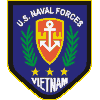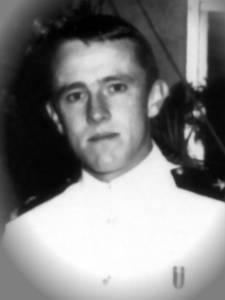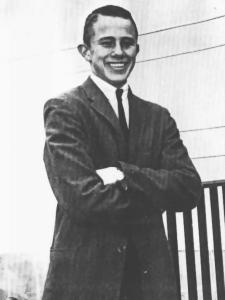Robert Leroy CrosbyLieutenant (junior grade)YFBN-2, COSDIV 12, TF 115, USNAVFORV United States Navy 24 December 1943 - 26 September 1969 South Hamilton, Massachusetts Panel 17W Line 009 |
 
|
 
|
The database page for Robert Leroy Crosby
|
REMEMBEREDby a fellow Swift Boat sailor,Terry Boone mtboone@aol.com |
|
From the yearbook of Lenox School for Boys 1961:
After graduation, Bob went to Cornell University and graduated with an engineering degree. He was, I am told, accepted into a master's degree engineering program at Cornell and due to return there. Thirty years after Bob Crosby's death one of his high school teachers wrote this:
Another classmate wrote, "As I age, I think more and more of Bob and the wonderful future he had ahead of him.". Robert Crosby is mentioned in several places in Douglas Brinkley's book Tour of Duty. One of the most poignant is an author's note on Page 481:
Many of Robert Crosby's classmates write of this classmate's death often. It was and is a profound loss for us. For some , it intrudes upon our thoughts and consciences even years later after the death and years after we last saw him. You see, there is a tear that clouds the vision and memory of some. And for this classmate, Robert Crosby, his classmates will always have a tear. You see, our class really liked Robert Crosby and we miss him greatly.
Howard Prestwich 27 May 2005 Robert Crosby was shot aboard Swift Boat PCF-13 by a round accidentally fired from the rear .50 caliber Browning machine gun. The distance was 3-4 feet. Also injured in the incident was Lieutenant (junior grade) John W. Hoeche. This happened September 24, 1969 at about 6:28 PM. Crosby was on board as instructor, Hoeche and his crew as under instruction. Hoeche was injured by the muzzle blast but administered almost immediate first aid and comfort to Cosby and continued to do so until placed in a stretcher. The gun and expended shell were later examined at the Naval Armory on site. The gun was "in excellent condition" but the chamber was "badly corroded". The ammunition was "in a similar (green) corroded state". They thought "the round was in the chamber at least 24 hours prior to being fired". The firing mechanism and trigger release "pressure was normal". The base of the expended shell was measured with a micrometer and the outside diameter of the base was increased .005 inch compared to the next shell in line in the belt. This expansion was thought insufficient to account for it not being automatically extracted. Those examining the gun felt the expended cartridge failed to extract from the T-slot due to the poor state of cleanliness in the T-slot, lack of lubrication and corrosion on the base of the cartridge. It was also determined that the weapon was locked in elevation at 5 degrees and at 170 degrees to train. This would mean the barrel was pointing slightly above level, and aimed almost directly astern. The vessel was assigned to Crosby and Hoeche for a coastal patrol at about 5:00 PM that day. The officers and crew prepared the boat for a patrol. At 6:10 the crew removed the canvas cover on the rear gun 75% of the way. A crew member noted a belt of ammunition fed into the gun. The top cover plate of the weapon was unlatched. The crew was surprised that the belt with ammunition was fed into the gun. They noted two shells were inboard of the feed pawl. The crew did not look into the receiver. The belt was removed. One crew member attempted to pull the bolt of the weapon back with the cocking handle. He only pulled the bolt back 3/4 of an inch when his hand slipped on the handle and the bolt went forward again. The crew member changed his position and after wiping his hand, pulled again with his right hand but he slipped and hit the trigger with his left thumb, said a witness. The gunner said the weapon discharged as he started to pull back the cocking handle. The ambulance took Crosby to the 95th Evacuation hospital, Danang, about 7:00 PM September 24th. Then on September 26 he was transferred to the Third Field Hospital Saigon, where he died. Lt Commander Paul E. Dodson, Jr. conducted the investigation into the incident. The documents released to me under the Freedom of Information Act total about 100 pages. I think some of the participants might not be fully aware of all the facts of the case such as how the gun was accidentally fired and events of PCF-13 in the hours just before the incident. The book by the Zumwalts, My Father, My Son (1986), which is dedicated in part to Robert Crosby, deals with the incident and leads me to this conclusion. The Hoeche crew arrived in Vietnam on September 14 1969, ten days before the incident, and reported to Coastal Division 12 on September 16. The crew's first patrol together was to be this patrol. The crew started out that day on PCF-78, departing just before noon on the 24th. But they returned about 2:00 PM for repairs, went out again and returned. They decided that PCF-78 was in no condition to go on patrol and to transfer to PCF-13. They transferred their gear and supplies to the new vessel. On September 24, PCF-13 was used in another training mission. A quartermaster received permission to take PCF-13 out for his ground school of six Vietnamese sailors. He got underway at about 2:30 PM and went to Danang harbor for drills. The first hour was spent on man-overboard drills using the life ring. Then he spent time on radar tuning and taught the students how to use the Decca 202 radar. They did bumper drills at the Vietnamese Naval Base. At 3:15 a skimmer informed him to return to base and he arrived there at 3:30 PM. The quartermaster gave a statement but the Vietnamese personal were not interviewed. He said none of the students tampered with the after mount. PCF-13 was used on patrol by another crew, the Zumwalt crew, on the night of September 22. The weapon was fired that night at a Sampan. They towed the Sampan and went out on patrol 3:30 AM the next morning and patrolled until about 11:00 AM that morning. The boat was returned to dock at about 3:30 the afternoon of September 23. The gunner for the rear mount left the weapon unloaded and his crew members back him up, especially his vessel commander. One crew member said the top door of the .50 was opened and the belt removed, the operator jacked the handle back, removed the round which fell to the deck. It was thrown overboard. They left the rear gun with one round of the ammo belt inboard of the feed pawl. The investigator's original conclusion was that the incident was not caused by the intent, fault, negligence or inefficiency of Navy persons. The second review of the report by J. J. Shanahan did not agree with this conclusion as did subsequent persons in the chain of review, but fault was never assessed. I conclude generally in war there are terrible mistakes. The remembrance of these errors can be fearsome and painful. It is my hope that the dark of night brings each sailor peace and the dawn of day brings new hope for accomplishment and fulfillment. Sleep should bring each sailor and former sailor dreams of home.
From a classmate, |
|
At Cornell, Bob was a much loved member of Sigma Alpha Epsilon Fraternity, Class of 1965. In June, 2005, a major gift will be given in Bob's name. Contributors will include SAE's, Swift boat veterans, and old friends from South Hamilton. Along with other memorabilia, the flag from Bob's boat will be framed and permanently hung in a place of honor.
From a fraternity brother, |
Notes from The Virtual WallLieutenant (junior grade) Robert Crosby arrived in Vietnam in the fall of 1968 and was assigned duties as the Officer-in-Charge of a "swift boat", formally titled a "Patrol Craft, Fast" or PCF. Until 1967 the PCF force had concentrated on MARKET TIME patrols off the South Vietnamese coast, interdicting shipborne supplies intended for NVA/VC forces operating within South Vietnam. By the time LTJG Crosby arrived, the PCFs had gained another role within the riverine war, conducting patrols and providing escorts far up into South Vietnam's rivers.Crosby's PCF was part of Coastal Division 11 based at An Thoi on Phu Quoc Island in the Gulf of Thailand. From An Thoi and smaller bases established along the rivers, the boats of CosDiv 11 patrolled both the coastal waters and the river network which forms the Mekong Delta. Toward the end of his tour, LTJG Crosby was transferred to duties as the Maintenance Officer for Coastal Division 12 at Danang in northern South Vietnam. CosDiv 12's maintenance functions were conducted from the barracks barge YFBN-2 and repair barge YR-71. On 24 Sep 1969 while Crosby was aboard PCF-13, berthed alongside YFBN-2, he was struck at point-blank range in the abdomen by a single accidently discharged .50 caliber round. Although treated at once at the Naval Hospital Danang and transferred to the Army's 3rd Field Hospital in Saigon, he died of his injuries on 26 Sep 1969. |
|
The point-of-contact for this memorial is one who remembers, Terry Boone mtboone@aol.com 12 Oct 2002 |
|
Top of Page
www.VirtualWall.org Back to |
With all respect
Jim Schueckler, former CW2, US Army
Ken Davis, Commander, United States Navy (Ret)
Last updated 06/11/2005

